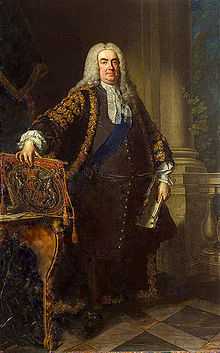Charles Talbot, 1st Baron Talbot


- See also Charles Talbot (disambiguation)
Charles Talbot, 1st Baron Talbot PC (1685 – 14 February 1737) was a British lawyer and politician. He was Lord Chancellor of Great Britain from 1733 to 1737.
Talbot was the eldest son of William Talbot, Bishop of Durham, a descendant of the 1st Earl of Shrewsbury. He was educated at Eton and Oriel College, Oxford, and became a fellow of All Souls College in 1704. He was called to the bar in 1711, and in 1717 was appointed solicitor general to the prince of Wales. Having been elected a member of the House of Commons in 1720, he became Solicitor General in 1726, and in 1733 he was made lord chancellor and raised to the peerage with the title of Lord Talbot, Baron of Hensol, in the County of Glamorgan.
Talbot proved himself an equity judge of exceptional capacity and of the highest character during the three years of his occupancy of the Woolsack. Among his contemporaries Talbot enjoyed the reputation of a wit; he was a patron of the poet James Thomson, who in The Seasons commemorated a son of his to whom he acted as tutor; and Butler dedicated his famous Analogy to the lord chancellor. The title assumed by Talbot was derived from the Hensol estate in Pendoylan, Glamorgan, which came to him through his wife.
Talbot is also remembered as one of the two authors of the Yorke–Talbot slavery opinion whilst he was a crown law officer in 1729. The opinion was sought to determinate the legality of slavery and Talbot and (Philip Yorke, later Lord Hardwicke) opined that it was. The opinion was disseminated and relied upon widely prior to the decision of Lord Mansfield in Somersett's Case.
References
- Lord Campbell, Lives of the Lord Chancellors and Keepers of the Great Seal (8 vols. London, 1845–69)
- Edward Foss, The Judges of England (9 vols. London, 1848–64)
- Lord Hervey, Memoirs of the Reign of George II ( 2 vols. London. 1848)
- G. E. Cokayne, Complete Peerage, vol. vii. (London, 1896)
References
 This article incorporates text from a publication now in the public domain: Chisholm, Hugh, ed. (1911). Encyclopædia Britannica (11th ed.). Cambridge University Press.
This article incorporates text from a publication now in the public domain: Chisholm, Hugh, ed. (1911). Encyclopædia Britannica (11th ed.). Cambridge University Press.
| Parliament of Great Britain | ||
|---|---|---|
| Preceded by Sir Edmund Prideaux James Craggs |
Member of Parliament for Tregony 1720–1722 With: John Merrill from March 1721 |
Succeeded by James Cooke John Merrill |
| Preceded by George Baker Thomas Conyers |
Member of Parliament for City of Durham 1722–1734 With: Thomas Conyers to 1727 Robert Shafto 1727–1730 John Shafto from 1730 |
Succeeded by Henry Lambton John Shafto |
| Legal offices | ||
| Preceded by Clement Wearg |
Solicitor General for England and Wales 1726–1733 |
Succeeded by Dudley Ryder |
| Political offices | ||
| Preceded by The Lord King |
Lord Chancellor 1733–1737 |
Succeeded by The Lord Hardwicke |
| Peerage of Great Britain | ||
| New constituency | Baron Talbot 1733–1737 |
Succeeded by William Talbot |
| ||||||||
| ||||||||||||||||||||||||||||||||||||||||||||
|
.svg.png)
